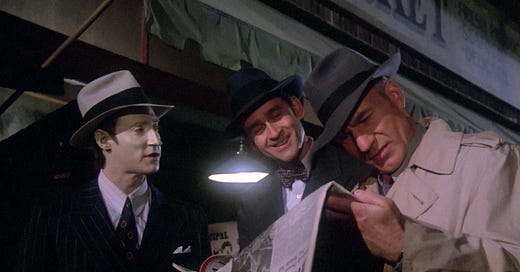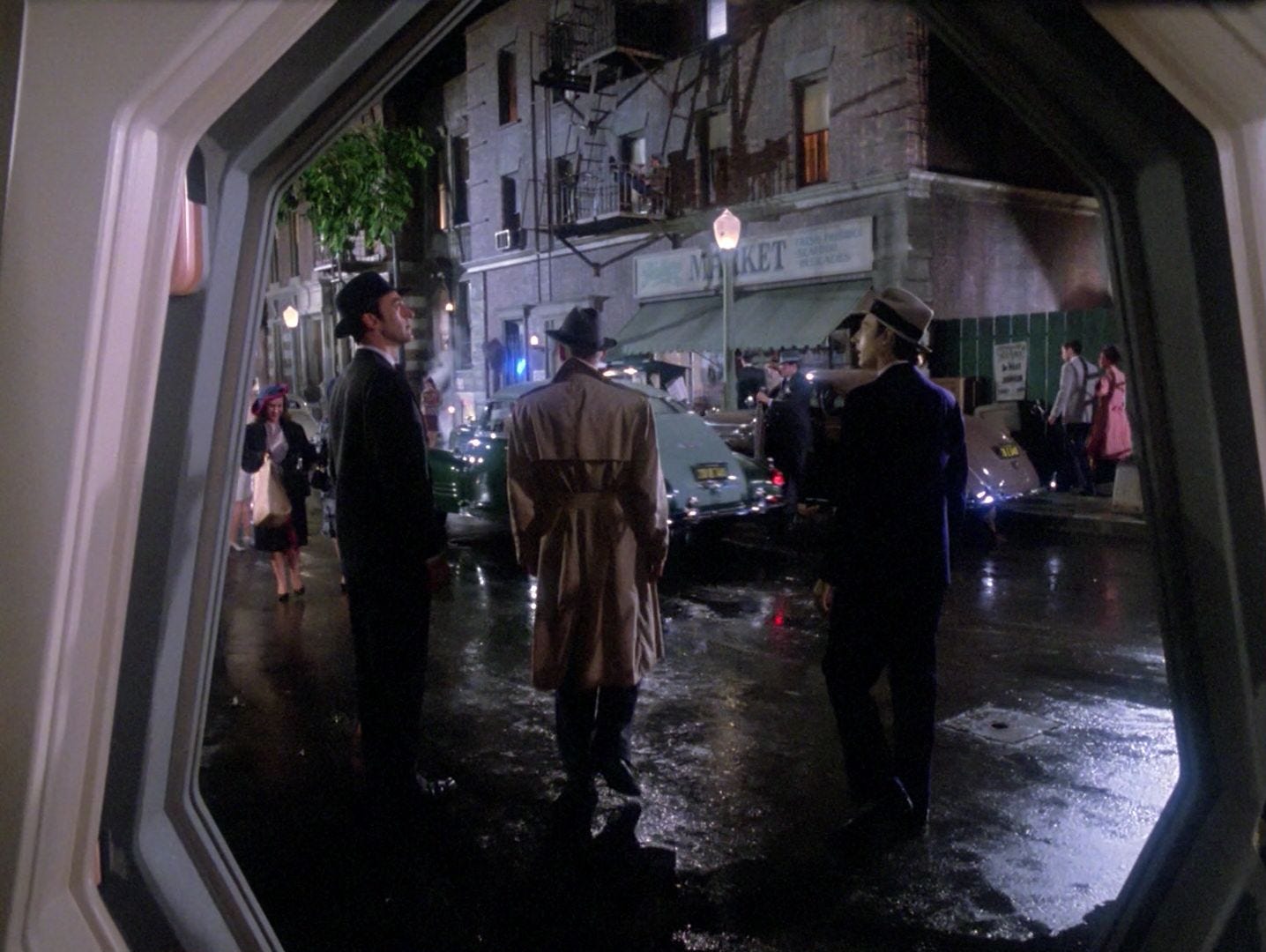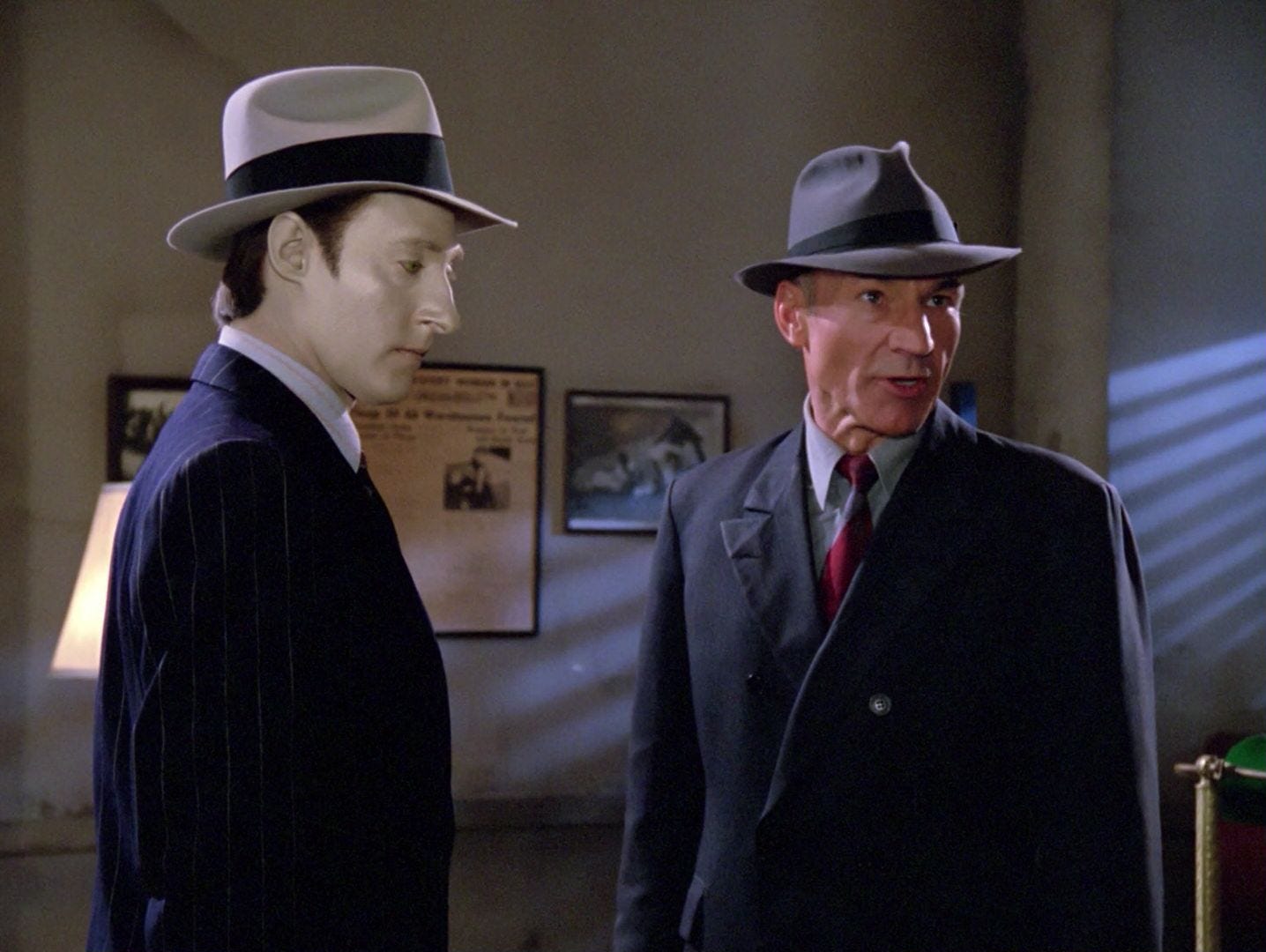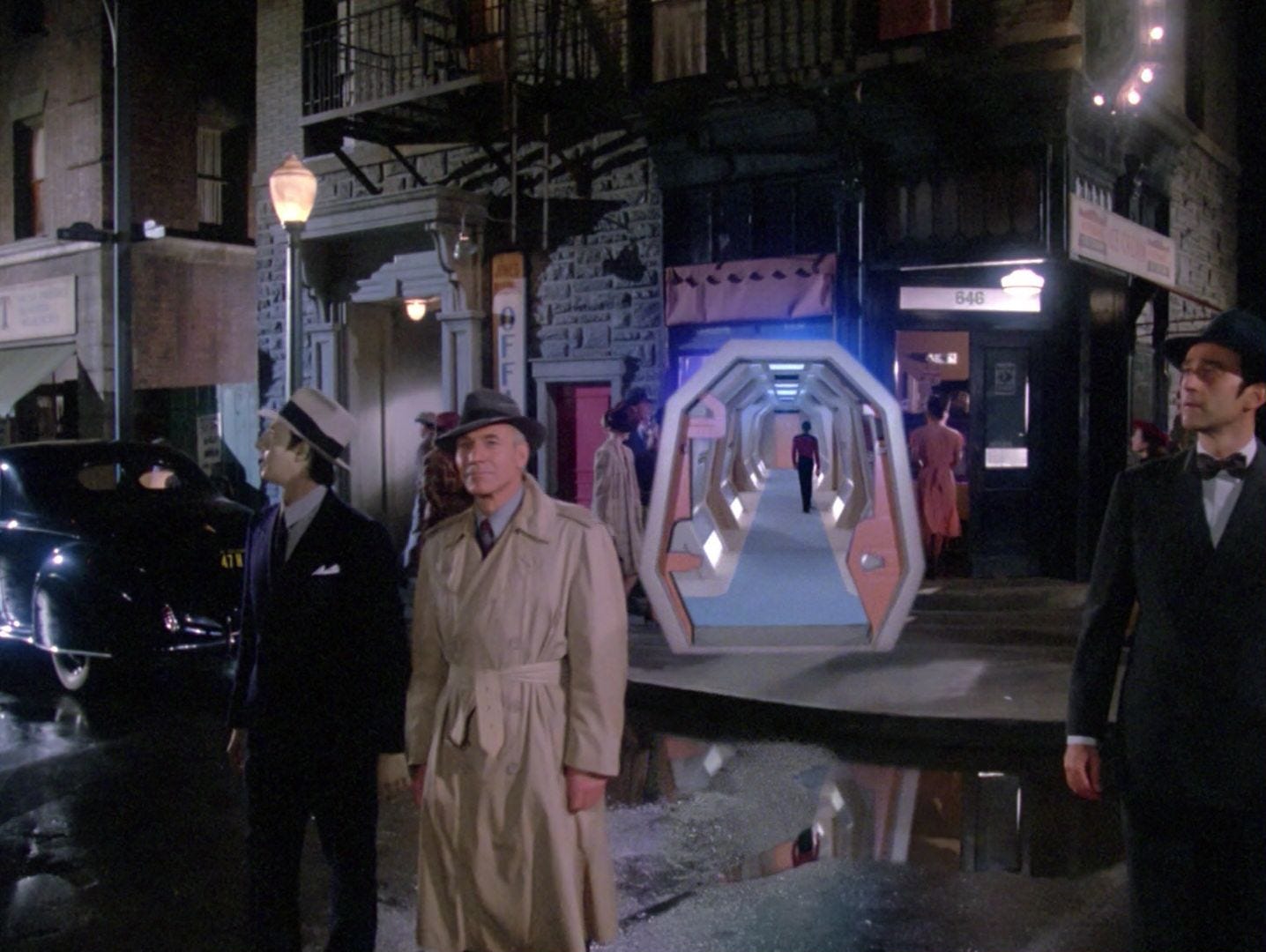Riker is in command, but refuses to sit in the captain's chair because he knows that without a beard he's just not good enough for the big chair. Meanwhile, Counsellor Troi is training Picard to speak an incomprehensible alien language so the captain can butter up the Jarada (pronounced 'Harada'). Troi uses her amazing powers of empathy to detect the obvious: the captain is stressed. Perhaps he should try the newly upgraded holodeck for some recreation...? And so he does - and is amazed at its ability to conjure up the New York Streets set that’s just outside the studio in the Paramount lot.
So he drags in Doctor Crusher and a disposable history expert, and Data comes along for the ride too. It's all fun and games in fake 1941 San Francisco until the holodeck malfunctions and our expendable crew member gets expended. There follows some chewing of the scenery until the bad guys discover the arch and try to leave the holodeck. Whoops. Seems like only lipstick stains can leave the holodeck. Fortunately, Picard is inspired by having his crew threatened by imminent death and delivers the speech to honour the Jarada perfectly. But what about the injured historian…? Well, nobody cares about him.
Words
This script is drawing enormously from the work of Raymond Chandler, whose fictional detective Philip Marlowe is justly considered the epitome of the hard-boiled private detective. Whenever Chandler's books are used as inspiration, there's always a little crosstalk from Dashiell Hammett's Sam Spade, and inevitably these kinds of stories draw heavily on the film adaptations of these novels, many of which starred Humphrey Bogart. When I was working on Discworld Noir with Terry Pratchett, this was precisely the playbook I was drawing against, and both Chandler's novels and Bogart's movies are irresistible source materials for 'film noir' stories.
The plot and the characters largely riff on the Bogart-starring John Huston movie The Maltese Falcon, which adapts a Sam Spade novel, but it it is Chandler's titles that the script mainly chooses to reference. The Big Good-Bye loses the hyphen for the episode title, but has it on the Okudagram, above. It’s a name that mashes up Chandler’s masterwork, 1939's The Big Sleep, with 1953's less satisfying The Long Good-Bye. Unfortunately, rather than drawing against the rich plots of the Chandler novels, Tracy Tormé's script largely just cobbles together every gumshoe cliché imaginable, and expends tremendous effort on selling the idea that the upgraded holodeck is truly amazing. As fans of the show, this is a tough sell for us, as we're completely acclimatised to this kind of story thanks to the later episodes, so the attempt to make it seem remarkable no longer has any impact.
The name of this episode’s writer actually appears in an Okudagram (above) as the author of the Dixon Hill stories… I view this as an easter egg, and not automatically a canonical claim, but it’s totally up to every individual to decide how to draw their fanonical lines.
The other leg of the script is the ticking clock provided by the Jarada. It works, in so far as it provides us an end point for the story, but as time pressure plot devices go it's not terribly interesting.
Acting Roles
You can't go far wrong with a Picard episode, because then you have Patrick Stewart to prop up your story, no matter how weak the script might be. He's not given much to work with here, but this is the first time that he's paired with Brent Spiner's Data, a double act that works extremely well and becomes one of the go-to pairings for the show as it progresses. There's many a great teaser featuring the two actors in the episodes ahead.
It's a shame that Gates McFadden is treated so shabbily by the script... intriguingly, her actual content in the final show is far richer than the material the writer gave her. In the script, she's alarmed that Picard is being interrogated - in the final show, she's titillated and wants to play along. In the script, she's instructed to be "struggling with her handbag"; in the show, she tries to work a compact and amusingly swallows some gum.
There's also a simple but pleasing scene between LeVar Burton and Spiner that gives Data the motivation to tag along for the ride, thanks to namechecking Sherlock Holmes. Once again, Spiner is given a couple of good comedy moments, including helping Stewart close up the story with some hardboiled call backs.
Shame the guest cast is so weak. David Selburg, who pays the unfortunate historian Whalen, will return in season six's "Frame of Mind", which is an infinitely better episode to be associated with, and he has two other roles in the later Trek franchises too.
Lawrence Tierney's Cyrus Redblock is pretty clichéd. The character name is a reference to Sydney Greenstreet, who played Kasper Gutman in The Maltese Falcon (and became the troll Horst in Discworld Noir), whom this character is based upon. Even more obvious is Harvey Jason's performance as Felix Leech, which is riffing off Peter Lorre's Joel Cairo (the dwarf Al Khali in Discworld Noir) from the same movie. Tierney will be back briefly in DS9 for one episode, but this is Jason's only Trek story. Allegedly he bullied Wil Wheaton during the filming of this episode, but I’ll treat that as hearsay.
Redblock and Leech are looking for 'the item'... which is never expanded upon, but is clearly drawing against the core plot device (and title) of the same film, The Maltese Falcon. I personally find it jarring that there's so much Chandler in the Dixon Hill titles but almost all the story content is from the Huston movie, which isn't even a Chandler story. Honestly, though, I can hardly criticize Tormé for drawing against such a brilliant movie when I did exactly the same in my own private investigator story, but at least I managed to build in some actual Chandler-style plotting for Discworld Noir. There's nothing close to that going on in this episode, sadly.
Models, Make-up, and Mattes
So, holographic lipstick can leave the holodeck…? Well, it's a nice gag, and you can defend it with your fanon if you wish.
This is essentially a 'bottle show', which is to say, a show in which the special effects costs and location shooting costs are kept low in order to save budget for the more expensive episodes (or to pay for the cost overrun of episodes earlier in the schedule). To my knowledge, this term was only used on the later Star Trek franchises, starting with TNG, where it comes from the idea of 'bottling up the action'. There are some rather good bottle shows, though - just as some of the expensive episodes are still rather poor - and for season one, I'd say "The Big Goodbye" is a pretty good bottle show, all in all.
While there may not be any fun studio miniatures in this episode, there is still a great spaceship model! It's the rogue Constitution-class model in Picard's ready room that sometimes appears in season one instead of the Constellation-class model that I'm going to continue to insist is of the Stargazer whatever its registry says. Take a look!
More than in earlier episodes, digitally compositing the arch so that the Enterprise corridors are visible within the holodeck scene is the big special effect moment. We've seen this before many times, but because the earlier environments have all been much simpler (that's the holodeck upgrade for you), the street scene here has a much stronger impact.
The New York Streets set was a permanent feature of the Paramount Pictures lot, and has been used for all sorts of things in Trek history. However, given the original version of the set was destroyed by a fire in 1983, this is in fact this version's debut on a Star Trek TV show. We'll see it twice more on TNG, four times on DS9 (including "Far Beyond the Stars", which is arguably that show's finest episode), twice on Voyager, and, well, nobody cares how often it appears on the show after Voyager with the terrible opening music.
There is a lovely use of a something akin to a smash cut when the holodeck completely malfunctions and this part of the script is executed:
Suddenly, the ENTIRE SETTING CHANGES and all involved find themselves in A SNOWY ALIEN LANDSCAPE. The wind is howling like a bitch, driving Leech to his knees and ripping the hat off the thug's head.
The place we cut to is of course Sound Stage 16, which we saw last week as a generic holodeck locale as well. This eventually picks up the nickname 'Hell Planet' or 'Planet Hell' (depending upon who you talk to), but it doesn't get the iconic tunnel polystyrene until closer to the end of this first season. Something to look forward to.
















As the Holodeck became an over used plot device - dare I utter such a critical thing, since it's essential tech in my own TNG episode - we tend to forget just how awe inspiring and fun the early holo eps remain, with 'Elementary, Dear Data' probably the best ep to fully employ the mind blowing potential of Trek holography.
I vividly recall watching it first run and thinking, 'Next Gen is truly blossoming' - later learning 'The Big Goodbye' inspired 'Elementary, Dear Data'.
I do like this episode but the malfunctioning holodexk does seem a recurring theme. Halfway through your review I got distracted by your mention of discworld noir and now am trying to work out how I can play this classic game again!